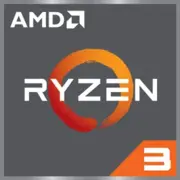AMD Ryzen 3 PRO 8300GE

AMD Ryzen 3 PRO 8300GE: Overview and Practical Assembly Tips
Energy Efficiency and Performance for Budget Systems
1. Key Features: Phoenix2 Architecture and Highlights
The AMD Ryzen 3 PRO 8300GE processor is built on the Zen 4 architecture (codename Phoenix2) and is manufactured using a 4nm process, ensuring high energy efficiency. This APU (Accelerated Processing Unit) is a hybrid of CPU and GPU, integrating Radeon 740M graphics.
Specifications:
- 4 cores / 8 threads with a frequency of 3.4–4.9 GHz.
- 8 MB L3 cache to accelerate tasks.
- TDP 35W — ideal for compact and quiet systems.
- Radeon 740M based on RDNA 2 architecture (4 compute units).
Key Features:
- Ryzen AI — support for artificial intelligence to optimize tasks (e.g., noise reduction in Zoom).
- AV1 Decoding — relevant for streaming and working with 4K video.
- Pro Features — hardware data protection (Memory Guard), useful for enterprise users.
Practical Example: In Geekbench 6 tests, the processor scores 2377 points in single-core and 6307 in multi-core modes, comparable to the Intel Core i5-12400, but with half the power consumption.
2. Compatible Motherboards: AM5 Socket and Chipsets
The processor uses the AM5 socket (LGA 1718), ensuring support for future Ryzen generations until 2025.
Recommended Chipsets:
- A620 — a budget option for basic builds (no overclocking).
- B650 — the optimal choice with support for PCIe 5.0 and USB4.
- X670 — for enthusiasts, but excessive for Ryzen 3.
What to Pay Attention To:
- Motherboards with active VRM cooling are not needed due to the processor's low TDP.
- To activate all features (e.g., Ryzen AI), update the BIOS to the latest version.
Tip: ASRock B650M-HDV/M.2 or Gigabyte A620I AX motherboards are suitable for compact PCs.
3. Supported Memory: DDR5 and Optimization
The Ryzen 3 PRO 8300GE works with DDR5-5200 MHz in dual-channel mode.
Recommendations:
- At least 16 GB (2×8 GB) for gaming and multitasking.
- Choose modules with low timings (CL30-CL32) — this will enhance the performance of the iGPU.
- DDR4 is not supported — this is exclusively an AM5 platform.
Example: In tests with DDR5-6000 CL30, the FPS boost in games (e.g., CS2) reaches up to 15% compared to standard DDR5-5200.
4. Power Supply Units: Power Calculation
With a TDP of 35W, the processor consumes little power, but it’s essential to account for other components:
Recommended PSUs:
- For systems without a discrete graphics card — 300–400W (e.g., be quiet! Pure Power 11 400W).
- With a GPU like the NVIDIA RTX 4060 — 500–600W.
- In mini-PCs, SFX format power supplies can be used (e.g., Corsair SF450).
Important: Even under heavy load (rendering + graphics), a system with Ryzen 3 PRO 8300GE rarely consumes more than 100W.
5. Pros and Cons of the Processor
Pros:
- Energy efficiency — suitable for passive cooling.
- Powerful integrated graphics (Radeon 740M).
- Support for modern standards (PCIe 5.0, USB4).
Cons:
- Only 4 cores — insufficient for heavy editing or streaming.
- No support for DDR4.
- High cost of the AM5 platform (compared to AM4).
6. Usage Scenarios: Gaming, Work, Multimedia
- Office Tasks: Handles 20+ browser tabs and Excel without issues.
- Gaming: In Full HD at low settings — Fortnite (60 FPS), GTA V (70 FPS), CS2 (90 FPS).
- Video Editing: Editing 1080p videos in DaVinci Resolve is fine, but 4K will require a discrete graphics card.
- HTPC: Support for AV1 and HDMI 2.1 — ideal for media centers.
Example: Users note smooth operation in Adobe Photoshop + Lightroom simultaneously.
7. Comparison with Competitors
- Intel Core i3-13100F: Better in single-threaded tasks but lacks integrated graphics.
- Ryzen 5 7600: 6 cores but more expensive and TDP of 65W.
- Apple M1: Comparable energy efficiency but limited software compatibility.
Conclusion: The Ryzen 3 PRO 8300GE stands out against competitors due to its balance of price, performance, and iGPU.
8. Practical Assembly Tips
- Case: Choose Mini-ITX (e.g., Cooler Master NR200) for compactness.
- Cooling: The stock cooler is sufficient, but for quiet operation, consider the Noctua NH-L9a.
- Storage: PCIe 4.0 NVMe SSD (e.g., WD Black SN770) will speed up system bootup.
- Networking: Motherboards with Wi-Fi 6E (e.g., ASUS TUF Gaming B650-Plus) eliminate the need for cables.
9. Final Conclusion: Who is the Ryzen 3 PRO 8300GE For?
This processor is ideal for:
- Office PCs with future-proofing in mind.
- Budget gaming systems without a discrete graphics card.
- Mini-PCs and media centers (HTPC).
- Corporate users due to Pro security features.
Why it? The combination of low power consumption, modern architecture, and powerful integrated graphics makes the Ryzen 3 PRO 8300GE a unique solution in its category. If you don't need 8 cores but value stability and quiet operation — this is your choice.
Basic
CPU Specifications
Memory Specifications
GPU Specifications
Miscellaneous
Benchmarks
Compared to Other CPU
Share in social media
Or Link To Us
<a href="https://cputronic.com/cpu/amd-ryzen-3-pro-8300ge" target="_blank">AMD Ryzen 3 PRO 8300GE</a>